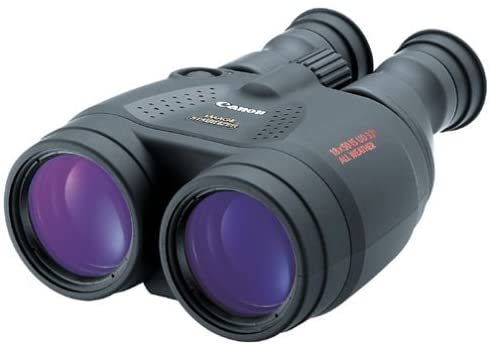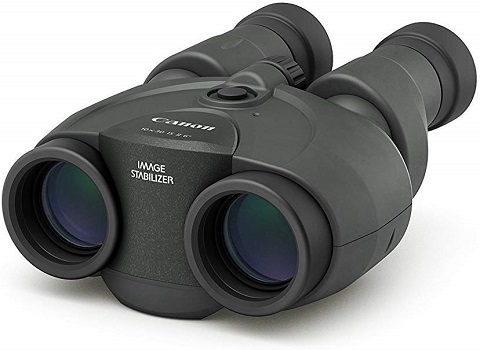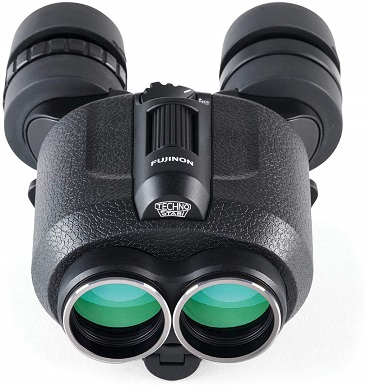5 Best Image-Stabilized Binoculars of 2024 – Reviews & Top Picks
Last Updated on

It’s important to know that there are binoculars, and then there are binoculars — image-stabilized binoculars, to be exact.
Whether by bending light or using an internal gyro, these binoculars will give you a crystal-clear, still image of what you are looking at. They may cost more than just an everyday pair of binoculars, but depending on what you are using them for, they could be worth it!
In these reviews, we picked out a handful of image-stabilized binoculars that we think are worth your attention.
These are products ranging from the best bang for your buck all the way to the highest end. On to the reviews!
A Quick Glance at Our Favorites (Updated in 2024)
| Image | Product | Details | ||
|---|---|---|---|---|
| Best Overall |
 |
Canon 18×50 |
|
CHECK PRICE |
| Best Value |
 |
Canon 10×30 |
|
CHECK PRICE |
| Premium Choice |
 |
ZEISS 20-20x60 |
|
CHECK PRICE |
 |
Fujinon Techno 14×40 |
|
CHECK PRICE | |
 |
FUJINON Techno 16X28 |
|
CHECK PRICE |
The 5 Best Image Stabilized Binoculars
1. Canon 18×50 Image Stabilization Binoculars – Best Overall

The first item on our list comes from Canon, a company typically known for cameras, but these binoculars are serious. Not only are these top of class in image stabilization, but they can also stand up to any rough element.
Made to give you shake-free viewing, this pair of binoculars is meant for the long haul, whether you’re out hunting or watching the football game from the nosebleeds. Using technology first designed for video cameras, this camera has stabilization that makes for a comfortable experience with extended use — basically, your eyes won’t get too tired while using these. With other binoculars, eye fatigue can come from how much you shake while viewing things or how much the things themselves move. Canon’s IS (Image Stabilization) technology will mitigate the shaking on both ends, giving you a bright and focused view of whatever it is that you are viewing. We don’t praise them lightly; this is the same technology used for television and film. The IS technology is made possible by a VAP (Vari-angle Prism). The VAP takes into account the movement and vibrations of the user and the image and bends the light slightly to give you the clearest view possible. Able to magnify up to 18x, you’ll be able to not only see the ball game but also the movement of the grass in the field.
This product is also water-resistant. While the grip is firm and comfortable, wild things happen sometimes, so if you accidentally get bumped by an over-exuberant nacho eater and drop your binoculars, have no fear — they are shock-resistant as well. These binoculars use two AA batteries to enable the IS technology. Financing is also available with this product.
While the image you get is astounding, the actual design of the binoculars themselves is slightly uncomfortable. You’ll be able to ease into them, but it takes a moment. Also, the focusing takes time to get used to.
- Astounding images
- Class leading IS technology
- 18x magnification
- Financing options
- Focus and comfort a little odd at first
2. Canon 10×30 Image Stabilized Binoculars – Best Value

A value version of our top pick, this Canon pair is smaller, making them more portable and even more comfortable. They are also less capable of magnifying, only able to zoom up to 10x. Aside from that, however, you will find that these binoculars have all the other perks.
As these binoculars are made with a Porro-prism design, you will get cuttingly sharp images that stay clear no matter how much movement is involved. This is due to Canon’s IS technology, which mitigates vibrations not only from the image you are looking at but also from the user. Essentially, Canon has found a way to give you a stable image while eliminating the need for a tripod.
These binoculars are great for a variety of activities, whether it be bird spotting or watching the ball game. The eye relief on this device is good but not quite up to the standard of our top pick. This product also requires two AA batteries to function.
There are a few issues with these binoculars that aren’t deal-breakers but are certainly worth mentioning. The rubber coating can quickly become gooey and fall off. Also, the difference between normal mode and IS mode is night and day, which is probably by design, but it is hard to overlook the difference. IS mode is absolutely stunning, while the regular mode renders these as just an average pair of binoculars. With all that said, we think that these are the best image-stabilized binoculars for the money.
- IS technology
- No tripod needed
- 10x zoom
- Gooey rubber casing falls off
- Night and day difference between normal and IS modes
3. ZEISS Image Stabilization Binoculars – Premium Choice

If you are going to fully invest in a pair of binoculars, look no further than this one from Zeiss. Known to be the industry leader in binoculars, these use different technology than Canon to get image stabilization. While Canon uses electronics that require batteries, Zeiss binoculars are 100% mechanic. They stabilize with an internal gyro that completely mitigates movement on behalf of the user. The image itself is out of this world, as Zeiss uses world-class lenses for their products. This is the case in both standard and image stabilization mode. The quality of the image never fades either, even when you fully zoom all the way up to 20x magnification.
The construction is heavy-duty, but we aren’t so sure how they would hold up in awful weather. They do come with a heavy-duty carrying case, meaning that your investment will be protected from even the roughest of handling once inside. The lens themselves are handmade, which speaks to the quality. As for the price, it’s an investment. If you are looking for a pair of binoculars just to take to the ball game, you might want to look elsewhere.
While this product is of the highest quality in its class, only people with a trained eye will be able to tell. Sometimes in humid weather, you might experience what is called “purple fringing,” which is a little purple outline on the image you are looking at. These binoculars are also kind of heavy. While the image stabilization makes moot the need for a tripod, they are heavy enough that you might still want to use one.
All that said, these are truly expert binoculars, the type that real spotters use.
- Internal gyro image stabilization
- Heavy-duty construction
- 20x magnification
- Top of class
- Handmade lens
- Purple fringing
- Heavy for prolonged use
4. Fujinon Techno TS1440 14×40 Binoculars

A list of binoculars wouldn’t be complete without Fujinon. Before we get to the image stabilization, we want to point out that the lens itself is quite impressive, being phase coated with EBC material. The images you get in good light settings are crystal clear and sharp, and even images in darker settings also pop. Fujinon has made a pair of binoculars meant for all conditions, as they are fog-proof and waterproof, utilizing a nitrogen purge to make sure your brilliantly phased lens never fogs up.
Made to be used with four AA batteries, there are five levels of stabilization, which effectively lets you decide how long the batteries last. The image stabilization itself is impressive, and the build of the body makes these easy to hold and portable. They are, however, a bit heavy for their size.
These binoculars do have a history of mechanical failure. We are not saying that every pair fails, but it does seem common enough that at some point, you will need to have a tune-up. Unfortunately, interactions with Fujinon’s support team range from nightmarish to dreamlike. Twelve-month financing is available with this item.
- Five levels of stabilization
- Phase-corrected imaging
- Water and fog proof
- A bit on the heavy side
- Needs maintenance
- Inconsistent customer service
5. FUJINON Techno-Stabi 16X28 Binoculars

Much like our two products from Canon, this second pair of binoculars from Fujinon is a value version of the previous model. The battery time for these is less, and the stabilization is not as good. Instead of five different levels of stabilization, with these binoculars, you only get one. While you can get astronomical images with the above pair, with these, you might want to stick to birds and baseball.
The lenses are made to phase correct images, giving you a crystal-clear view in most light conditions. These are also made to be all-weather binoculars, though we have found that they have some difficulty in extreme cold, where they might fog up a bit and the battery life can be significantly lower. These are lighter than the other Fujinon binoculars but still pack 16x magnification.
- Great for bird watching or baseball
- All-weather design
- Fogs up in extreme cold
- Only one level of stabilization
Buyer’s Guide: Finding the Best Image-Stabilized Binoculars
Buying a pair of image-stabilizing binoculars is an exciting investment, but it is exactly that: an investment. The level of quality with binoculars of this type might be hard for the average person to discern, but an expert spotter can easily tell. So, what are a few things to look for when buying the best image-stabilized binoculars? Let’s take a look.
What’s your level of expertise?
Considering that the price range of image-stabilized binoculars can go all the way up to the price of a car, you might want to consider starting on the lower end of things if you are new to these products. Even value pairs offer wonderful views and images, and you might not be able to notice the difference between these and higher-end models.
What are you using them for?
While the best of the best can give you images of Jupiter’s moon, you probably won’t need something that fancy if your intended use is to watch the ball game. Different image stabilizers do different things as well. Some are better for bird watching, as they bend the light being received, stabilizing the moving image, which others are great when you yourself are moving, such as being in a boat, car, or airplane.
Do you need assistance?
Some companies offer financing on their products, while others do not. Looking into financing can turn your dream pair of binoculars into an everyday pair.
Where are you using them?
When it comes to weatherproofing, not all binoculars are the same, even in the higher end of things. Some offer the best image you could imagine but fog up in anything but perfect weather, while others may be less stable, but you could take them into a hurricane if you wanted and they would be just fine.
What’s the warranty?
We recommend this for any product you buy, but especially when you get into the price range of some of these binoculars. You’ll want to be sure that there is an available warranty and customer support.

Conclusion
Once you have figured out what you want to use your binoculars for, it’s much easier to make a narrow list of what you would like to buy. That’s why we’ve provided this resource in your search for the best image-stabilized binoculars. Whether you wind up with one of the two pairs from Canon, with arguably the best image once stabilized; pick one of the two from Fujinon, which you can take anywhere in any weather; or decide to go all out with the handmade, high-end binoculars from Zeiss, we are glad to offer these reviews to help your decision-making process.
Featured image credit: RitaE, Pixabay
About the Author Robert Sparks
Robert’s obsession with all things optical started early in life, when his optician father would bring home prototypes for Robert to play with. Nowadays, Robert is dedicated to helping others find the right optics for their needs. His hobbies include astronomy, astrophysics, and model building. Originally from Newark, NJ, he resides in Santa Fe, New Mexico, where the nighttime skies are filled with glittering stars.
Related Articles:
When Were Binoculars Invented? History, Today & Future
How to Clean a Refractor Telescope: Step-by-Step Guide
How to Clean a Telescope Eyepiece: Step-by-Step Guide
How to Clean a Rifle Scope: 8 Expert Tips
Monocular vs Telescope: Differences Explained (With Pictures)
What Is a Monocular Used For? 8 Common Functions
How to Clean a Telescope Mirror: 8 Expert Tips
Brightfield vs Phase Contrast Microscopy: The Differences Explained



